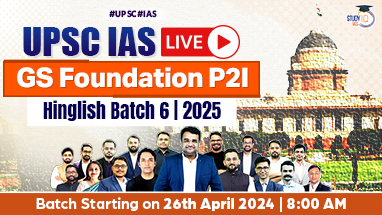Daily Current Affairs for UPSC 2022
Q) Recently seen in news, the ‘the Global Analysis and Assessment of Sanitation and Drinking-Water report 2022’, is released by which one of the following organizations?
- World Water Council
- Safe Water Network
- National Institute of Hydrology
- World Health Organization and UN-Water
Daily Current Affairs for UPSC – 15 December 2022
Explanation:
- Option (4) is correct: The World Health Organization (WHO) and UN-Water have jointly published the Global Analysis and Assessment of Sanitation and Drinking-Water (GLAAS) report 2022. The report compiles new data on water, sanitation and hygiene (WASH) from 121 countries and territories and 23 external support agencies. It serves as a global reference to inform commitments, priorities and actions during the second half of the 2030 Agenda for Sustainable Development and for the UN 2023 Water Conference. The report highlights opportunities to accelerate progress in key WASH areas, pandemic preparedness and resilience to climate change. Less than one third of countries reported they have more than 75% of the human resources needed to carry out key functions to deliver WASH services. The increasing frequency and intensity of extreme weather events caused by climate change continue to hamper the delivery of safe WASH services, thus affecting the health of users.
Q) With reference to Alternative Investment Fund (AIF), consider the following statements:
- Mutual funds are classified as AIF-Category 3 funds.
- AIF invests in economically viable start-ups that have high growth potential.
- AIF is a privately pooled investment fund that accepts investments solely from Indian investors.
Which of the statements given above is/are correct?
- 1 and 2
- 2 only
- 1 and 3
- 2 and 3
Explanation:
- Statement 1 is incorrect: Alternative Investment Fund (AIF) is a special investment category that differs from conventional investment instruments. These investment vehicles adhere to the SEBI (Alternative Investment Funds) Regulations, 2012. It does not include Mutual funds, funds covered under the SEBI (Collective Investment Schemes) Regulations, 1999, or any other regulations of SEBI (Securities and Exchange Board of India) regulating fund management activities. The objective of AIF is different from mutual funds. AIF is a highly risky investment whereas mutual funds are considered less risky and are available to retail investors.
- Statement 2 is correct: Category 1 type of Alternative Investment Fund (AIF) invest in SMEs, start-ups, and new economically viable businesses with high growth potential. These funds also include: Venture Capital Funds (VCF) which is new-age entrepreneurial firms that require large financing during their initial days can approach; Angel Funds invest in budding start-ups and are called angel investors; Infrastructure Funds invests in infrastructure companies, i.e., those involved in railway construction, port construction, etc; Social Venture Fund investing in a socially responsible business are social venture funds.
- Statement 3 is incorrect: Alternative Investment Funds (AIFs) refers to any privately pooled investment fund sourced from either Indian or foreign investors, in the form of a trust or a company or a body corporate or a Limited Liability Partnership (LLP). In India, alternative investment funds (AIFs) are defined in Regulation 2(1) (b) of Securities and Exchange Board of India (Alternative Investment Funds) Regulations, 2012. Hence, in India, AIFs are private funds which are otherwise not coming under the jurisdiction of any regulatory agency in India.
Q) Consider the following statements about the Social Progress Index (SPI):
- SPI will rank states and districts on account of the social progress made by them.
- SPI assesses the performance of states and districts on twelve broad dimensions of social progress.
- NITI Aayog is mandated to release SPI on an annual basis.
Which of the statements given above is/are not correct?
- 1 and 2 only
- 1 and 3 only
- 2 and 3 only
- 1, 2 and 3
Explanation:
- Statement 1 is correct: Social Progress Index (SPI) is a comprehensive tool to measure the social progress made by the country at the national and sub-national levels, through state and district-wise rankings and scorecards. The report also sheds light on the achievements of the districts that have performed well on the index and the role of the states in achieving social progress. A special section of the report provides an analysis of the Aspirational Districts of India, leading to a broader understanding of the social progress at the grassroots level.
- Statement 2 is incorrect: SPI assesses the performance of states and districts on three broad dimensions of social progress:
- The dimension of Basic Human Need: It assesses the performance of states and districts in terms of Nutrition and Basic Medical Care, Water and Sanitation, Personal Safety and Shelter.
- The dimension of Foundations of Wellbeing: It evaluates the progress made by the country across the components of Access to Basic Knowledge, Access to Information and Communication, Health and Wellness, and Environmental Quality.
- The dimension of Opportunity: It focuses on aspects of Personal Rights, Personal Freedom and Choice, Inclusiveness, and Access to Advanced Education.
At global scale, Social Progress Index 2022, published by the Social Progress Imperative, a US-based non-profit, uses its 12 components and 60 indicators to measure the social performance of 169 countries fully and an additional 27 countries partially.
- Statement 3 is incorrect: Economic Advisory Council to Prime Minister (EAC-PM) will release the Social Progress Index (SPI) for states and districts of India on December 20, 2022. Economic Advisory Council to the Prime Minister (EAC-PM) is an independent body constituted to give advice on economic and related issues to the Government of India, specifically to the Prime Minister. Its objective is to analyze any issue, economic or otherwise, referred to it by the Prime Minister and advising him thereon, addressing issues of macroeconomic importance and presenting views thereon to the Prime Minister.
Q) With reference to Particularly Vulnerable Tribal Groups (PVTGs), consider the following statements:
- At present, there are only 75 PVTGs classified in India.
- The absence of written language is one of the features of PVTGs.
- The PVTG population has been steadily declining since 1991.
- There are no PVTGs notified from the Union Territory of Lakshadweep.
Which of the statements given above are correct?
- 1, 2 and 3 only
- 3 and 4 only
- 1, 2 and 4 only
- 1, 2, 3 and 4
Explanation:
- Statement 1 is correct: Particularly Vulnerable Tribal Groups (PVTGs) is a separate category among tribals, who are less developed compared to other tribal groups. In 1975, the Government of India initiated to identify the most vulnerable tribal groups as a separate category called PVTGs. There are 75 groups of most vulnerable sections amongst the tribals who are classified as PVTGs.
- Statement 2 is correct: Some of the characteristics of PVTGs are that they are mostly homogenous, with a small population, relatively physically isolated, social institutes cast in a simple mould, absence of written language, relatively simple technology and a slower rate of change etc. Identification Criteria of PVTGs is pre-agricultural level of technology, low level of literacy, economic backwardness, a declining or stagnant population.
- Statement 3 is incorrect: PVTG population has been steadily rising. It increased from 0.77 million in 1961 to 1.4 million in 1971, some 2.26 million in 1981, then 2.41 million in 1991 and 2.76 million in 2001. PVTGs are scattered in different geographical areas of the country. There are 12 PVTGs having a population above 50,000 and the remaining groups have a population of 1000 or less. Data for 2011, the year of the last census, is not available.
- Statement 4 is correct: They are spread over 18 States and the Union Territory of Andaman & Nicobar Islands. Thus there are no PVTGs notified in the Union Territory of Lakshadweep. The PVTG of Sahariyas has the highest population of 4, 50,217, while the PVTGs of Sentinelets and Andamanese has a very small population of 39 and 43, respectively.
Q) Consider the following pairs:
| Geographical Indication (GI) Tag | Associated State | |
| 1. | Gamosa | Assam |
| 2. | Attappady Thuvara | Kerala |
| 3. | Raktsey Karpo Apricot | Himachal Pradesh |
| 4. | Tandur Redgram | Andhra Pradesh |
How many pairs given above are correctly matched?
- Only one pair
- Only two pairs
- Only three pairs
- All four pairs
Explanation:
Recently, the Union government has granted the Geographical Indication (GI) tag to 9 products, raising the total to 432 in the country.
- Pair 1 is correctly matched: Gamosa of Assam is a traditional textile having great significance for the people of Assam. In all rituals related to puja and ‘namprasang’, Gamosa is wrapped around the neck by both men and women.
- Pair 2 is correctly matched: The Attappady Thuvara (Red gram) is an important traditional crop of the Attappady tribal area in Palakkad district, Kerala. It is a woody shrub, generally grown as an annual crop. Another GI tag given to kerala is for Kanthalloor Vattavada Veluthulli (garlic). It is traditional garlic grown in prominent cultivation areas such as Kanthalloor and Vattavada panchayats in Kerala. It is known for its unique flavour, pungency, taste, medicinal properties and longer shelf life.
- Pair 3 is incorrectly matched: Raktsey Karpo Apricot is native to Ladakh and is known for its pure organic sweetness. It has a unique seed. The Raktsey Karpo fruit have white seed stones.
- Pair 4 is incorrectly matched: Tandur Redgram is a traditional crop in the rain-fed tract of the Telangana region. It contains about 22-24% protein, which is almost three times that of cereals. Tandur red gram is a local variety of pigeon pea which is mainly grown in the rainfed tract of the Tandur and nearby region of Telangana. The fertile deep black soil with huge deposits of Attapulgite clay mineral specifically in Tandur region along with huge limestone deposits can be attributed to the specific quality traits of Tandur red gram. It contains about 22-24% protein, which is almost three times that of the protein content in cereals.


 Current Affairs 27th April 2024 for UPSC...
Current Affairs 27th April 2024 for UPSC...
 Small Finance Banks, Key Features and Op...
Small Finance Banks, Key Features and Op...
 Glacial Lakes and Remote Sensing
Glacial Lakes and Remote Sensing

















